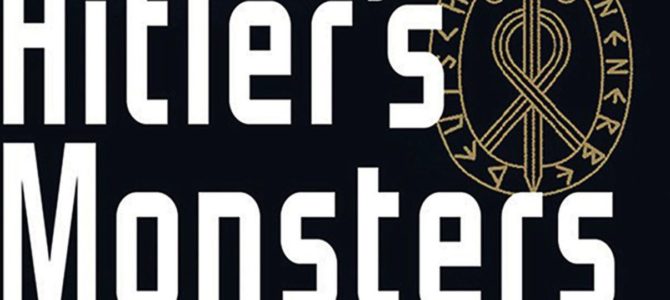
The Nazi fascination with fantastical science and the occult has long made for spectacular entertainment. From Indiana Jones trying to save the Holy Grail and the Ark of the Covenant from the Nazis, to comic-book super-soldier serums, to the reoccurring use of supernatural charlatanism to dupe the Germans in Hogan’s Heroes, pop culture has propagated the idea of the Nazis as obsessed with mysticism and mad science. And pop historians have eagerly provided background for these tales.
How much of it is true?
Quite a lot, it turns out. Recently released in paperback by Yale University Press, Eric Kurlander’s book Hitler’s Monsters: A Supernatural History of the Third Reich, provides a sober scholarly treatment of a subject that has frequently been sensationalized in pop history potboilers as well as pop culture. Dr. Kurlander, a history professor at Stetson University, has written a thorough overview of the intersections between Nazism and various mystical, occult, and pseudo-scientific theories. And there is a lot of material to work with, even if the less reliable claims are set aside.
The confusions of the Weimar Republic, following on Germany’s humiliating surrender in the First World War, accelerated a cultural drift away from empirical science and traditional religion. This space was filled by pseudo-science, mysticism, and religious experimentation.
Kurlander explains that “no mass political movement drew as consciously or consistently as the Nazis on what I call the ‘supernatural imaginary’ – occultism and ‘border science’, pagan, New Age and Eastern religions, folklore, mythology and many other supernatural doctrines.” This allowed them to attract those who sought “new forms of spirituality and novel explanations of the world that stood somewhere between scientific verifiability and the shopworn truths of traditional religion.”
Imagining Monsters
From astrology to racial mythology, the Nazi leadership was fascinated, in some cases enthralled, by a wide mix of pseudo-science and mysticism. And they put it into practice. “Nazi leaders sponsored everything from astrology, parapsychology and radiesthesia to biodynamic agriculture and World Ice Theory.”
The last of these was a particular favorite of both Adolf Hitler and Heinrich Himmler, who found its cosmology congenial to their mystical ideas about race. But their fascination with it may have contributed to the failure of Hitler’s invasion of Russia, as it discouraged proper German preparation for the bitter Russian winter.
Himmler and the SS were the locus of occultism and mysticism within the Nazi regime, but they were not alone. Kurlander relates that Hitler read and carefully annotated books on magic, and that he “hired Germany’s most famous dowser … to police the Reich Chancellery for harmful death rays.” Meanwhile, Rudolph Hess sponsored “astrology, anthroposophy, Buddhism, Hinduism, and Tibetan mysticism” and even consulted an astrologer before his flight to Scotland.
Many other Nazi leaders of varying importance dabbled in occultism and border science. Even the occasional Nazi suppressions of occultism were careful to distinguish between those they saw as commercial charlatans and those who practiced “scientific” versions of astrology or other occult or “border scientific” disciplines.
The academic style and the grim subject matter of this book do not lend themselves to humor. However, there are moments of levity, such as the description of the Nazi establishment of a “Pendulum Institute” to try to find enemy battleships by means of pendulum dowsing—which involved swinging pendulums over toy battleships placed on a large map of the Atlantic. The image of Nazis seriously trying to locate the British Navy by swinging weights over toy battleships is as amusing and outlandish as anything from Hogan’s Heroes.
However, Nazi mysticism was also part of the worst atrocities of the Third Reich. Nazi race theory was mystical and mythological. This often accorded practical flexibility—Nazi alliances with East Asians and Arabs, for instance, could be justified by claiming that these ethnicities, or at least their ruling classes, were descended from proto-Aryan stock. But Nazi racial mythology also fueled their genocidal policies.
Although many factors contributed to the Holocaust, the Nazis’ mystical conception of race was an indispensable motivation for their campaign of Jewish extermination. As Kurlander notes, absent “the supernatural figuring of the monstrous Jew, the highly technical process of genocide could never have been applied as widely or vociferously as it was.” In the Nazi spiritual imaginary, Jews were not just an inferior race, or a people with a degenerate culture; they were “vampiric, near omnipotent monsters whose sole purpose was to destroy Aryan civilization.”
For the architects of the Holocaust, the essence of Jewishness (biological and spiritual) was enmity to the Aryan race. Thus, they came to believe that even destroying Jewish culture and making them subservient was not enough; only extermination would suffice as a solution to the “Jewish problem.” As Kurlander explains, “Auschwitz…was the border scientific byproduct of the Nazis’ faith-based vision of racial purification and Aryan utopia.” They committed genocide as a sort of spiritual warfare. By imagining monsters, the Nazis became monsters themselves.
Still Stranger Gods
It is tempting but dangerous to draw moral comparisons between contemporary circumstances and the Third Reich. Comparing current wrongs to the enormity of the Nazi regime tends to diminish the latter without effectively warning against the former. Thankfully, except for a few desultory comments at the end of the book, Kurlander does not attempt to draw parallels between Nazism and our own conflicts and crisis.
He recognizes that the particular horrors of National Socialism are unlikely to repeat themselves. Although loathsome and sometimes murderous, neo-Nazi cosplayers and alt-right creeps are losers who do not pose a real threat to our constitution and culture. Donald Trump is not an orange iteration of Hitler. The populist governments of Poland, Hungary, and other European nations (welcome, Italy) are not Nazis.
If there is a warning to us in this book, Kurlander suggests it is about the dangers of a culture and its “supernatural imaginary” becoming untethered from “traditional religion and modern science.” Despite the hopes of secular humanists, the space left when traditional religions decline tends to be filled not by rational scientific empiricism, but by still stranger gods.
As Father Brown, G.K. Chesterton’s detective priest, explains, Christian orthodoxy provides a hedge against superstition. In one story, Father Brown is chided for skepticism regarding some supernatural claims: “You have no business to be an unbeliever. You ought to stand for all the things these stupid people call superstitious … It’s your business to believe things.” He replies simply, “Well, I do believe in some things, of course … and therefore, of course, I don’t believe other things.”
An orthodox Christianity could not also believe in a Nazified “Aryan Christianity,” let alone the rest of the mystical mélange of the Nazi supernatural imaginary. Thus, Nazi leaders “rejected Christianity, at least in its traditional form,” although they felt they could not fully confront the German churches until after the war. Shamefully, many German Christians did not oppose the Nazis, but this should not obscure the Nazis’ fundamental antipathy toward Christianity and their embrace of a decidedly non-Christian supernaturalism.
Eric Voegelin, a political scientist who fled Nazi Germany, diagnosed Nazism, along with communism, as a political religion. Kulander’s valuable book provides extensive documentation to support this analysis. Losing faith in orthodoxy does not mean losing the impulses and needs that seek satisfaction in religion; it merely means they will be redirected. Traditional religion may be perilous, but spirituality without it may be even more so. Monsters rush in where angels no longer tread.









